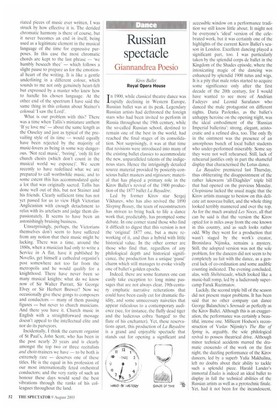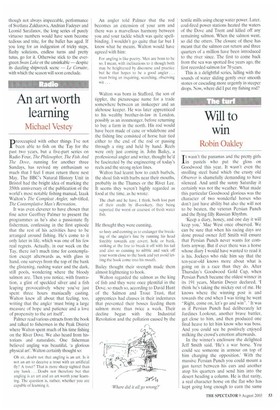Russian spectacle
Giannandrea Poesio
Kirov Ballet
Royal Opera House
In 1900, while classical theatre dance was rapidly declining in Western Europe, Russian ballet was at its peak. Legendary Russian artists had dethroned the foreign stars who had been invited to perform in Russia throughout the 19th century, while the so-called Russian school, destined to remain one of the best in the world, had reached the final stages of its consolidation. Not surprisingly, it was at that time that revisions were introduced into many of the existing ballet classics to accommodate the new, unparalleled talents of the indigenous stars. Hence the intriguingly detailed source material provided by posterity-conscious ballet masters and regisseurs; material that has played a primary role in the Kirov Ballet's revival of the 1900 production of the 1877 ballet La Bayadere.
Led by former Kirov star Sergej Vikharev, who has also revived the 1890 Sleeping Beauty, the team of reconstructors has striven to bring back to life a dance work that, predictably, has prompted some debate. In one corner stand those who find it difficult to digest that this version is not the 'original' 1877 one, but a mere reworking of it, and thus a hybrid with little historical value. In the other corner are those who find that, regardless of any philological depth and historical significance, the production has a unique 'passé' charm which still manages to evoke vividly one of ballet's golden epochs.
Indeed, there are some features one can easily take exception to: long mime passages that are not always clear, 19th-century emphatic narrative reiterations that could have been easily cut for dramatic fluidity, and some unnecessary naiveties that appear ridiculous to a contemporary audience (see, for instance, the fluffy dead tiger and the ludicrous cobra 'hanged' to the flute of his enchanter). Yet, these reservations apart, this production of La Bayadere is a grand and enjoyable spectacle that stands out for opening a significant and
accessible window on a performance tradition we still know little about. It might not be everyone's 'ideal' version of the celebrated work, but it was certainly one of the highlights of the current Kirov Ballet's season in London. Excellent dancing played a significant part, too. I was particularly taken by the splendid corps de ballet in the Kingdom of the Shades episode, where the intoxicating magic of the dancing was enhanced by splendid 1900 tutus and wigs. It is a pity that male roles started to acquire some significance only after the first decade of the 20th century, for I would have wanted to see more of Andrian Fadeyev and Leonid Sarafanov who danced the male protagonist on different nights. Dania Pavlenko, as the ballet's unhappy heroine on the opening night, was the ideal embodiment of the 'Russian Imperial ballerina': strong, elegant, aristocratic and a refined diva, too. The only fly in the ointment was the presence of an amorphous bunch of local ballet students who under-performed miserably. Some say they were not well rehearsed. Still, lack of rehearsal justifies only in part the shameful display that characterised the Lotus dance.
La Bayadere premiered last Thursday, thus obliterating the disappointment of the rather lukewarm 'all-Diaghilev' triple bill that had opened on the previous Monday. Chopiniana lacked the usual magic that the Kirov artists manage to bestow on this delicate art nouveau ballet, and the whole thing looked terribly mannered and over the top. As for the much awaited Les Noces, all that can be said is that the version the Kirov opted for is miles away from the one known in this country, and as such looks rather odd. Why they went for a production that wasn't staged by the work's creator, Bronislava Nijinska, remains a mystery. Still, the adopted version was not the sole problem, for the dancers did not seem to be completely au fait with the dance, as a general lack of co-ordination and some audible counting indicated. The evening concluded, alas, with Sheherazade, which looked like a music-hall romp, led by a ludicrously supercamp Faruk Ruzimatov.
Luckily, the second triple bill of the season did not present major problems. It has been said that no other company can dance George Balanchine's Serenade as perfectly as the Kirov Ballet. Although this is an exaggeration, the performance was certainly a beautiful, intense one. Millicent Hodson's reconstruction of Vaslav Nijinsky's The Rite of Spring is, arguably, the sole philological revival to possess theatrical drive. Although minor technical accidents marred the dramatic crescendo of the work on the first night, the dazzling performance of the Kirov dancers, led by a superb Yulia Makhalina, left no doubts about their ability to tackle such a splendid piece. Harald Lander's immortal Etudes is indeed an ideal ballet to display in full the technical abilities of the Russian artists as well as a pyrotechnic finale. Yet, had it not been for the incandescent,
though not always impeccable, performance of Svetlana Zakharova, Andrian Fadeyev and Leonid Sarafanov, the long series of purely virtuoso numbers would have soon become tedious and trite, for the ballet has aged. If you long for an indigestion of tricky steps, flashy solutions, endless turns and pretty tutus, go for it. Otherwise stick to the evergreen Swan Lake or the unsinkable — despite its dazzling shipwreck scene — Le Corsaire, with which the season will soon conclude.



































































 Previous page
Previous page